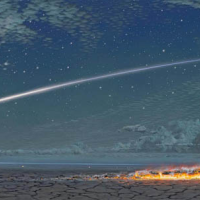50. TIM STORRIER Cloud Bank (Over the Night Road)

Tim Storriers burning objects are among the most recognisable and successful motifs in Australian contemporary art. They dominate his oeuvre and have brought him immense critical and commercial acclaim both in Australia and internationally. Yet their inception was a mere moment of sudden inspiration one evening on an outback trip in 1981. Storrier stuck some steel posts in the arid dirt, tied a rope between them and set it alight, and with it sparked the next decade of his career. Forever enigmatic, Storrier insists he cannot recall why he decided to do it or where the concept came from.1 These mysterious origins are a reminder of the highly personal nature of the process of making art.
Cloud Bank (Over the Night Road) is a truly exemplary Storrier yet its composition is grand in both conception and execution. A glorious shooting star cuts across the sky from right to left and gives the work an abrupt energy, while the various cloud formations sweep from left to right culminating above the burning log, creating a beautifully balanced composition. The log has been intentionally placed in the lower right of the work in order to hero the nights sky. Immense and visually spectacular skies have always been a dominant force in Storriers work, having grown up in the vast Western Plains of New South Wales. This awareness of space, low horizons and infinite skies demonstrates Storriers affinity with the Australian landscape. Edmund Capon, former director of the Art Gallery of New South Wales, commented on his works uniquely Australian quality, they could not, I believe, have come from any country other than Australia.2 Very few artists convey the sense of enormity of the Australian outback more poignantly than Storrier.
Storriers artistic practice has always been in opposition to the prevailing trends of the art world. Most artists of his generation have been strongly informed by the anti-object art movements of the 1970s, such as Imants Tillers (born 1950) and Mike Parr (born 1945), or the critical post-modern movements of the 1980s and 1990s.3 Storrier, on the other hand, had little time for cutting-edge art theory or avant-garde concerns, preferring to paint passionately and prodigiously, drawing inspiration from his own experiences of rural Australia. He is one of very few late twentieth century artists to explore the landscape in such detail, as the genre was so deeply dominated in the first half of the century by Australian artistic heavyweights such as Arthur Streeton (1867-1943), Tom Roberts (1856-1931), Arthur Boyd (1920-1999) and Sidney Nolan (1917-1992). Rather than let this history intimidate him, Storrier has brought the tradition into a contemporary context, stepping out from their shadows by creating his own unique visual language. His burning logs and dazzling skies, now iconic imagery in our nations contemporary visual culture, have successfully carved a place for himself in the longstanding tradition of Australian landscape painting.
One of the most impressive elements of Storriers practice is how he combines his skill for precise rendering with his grand visions of surreal and highly imaginative imagery. For example, in the present work he has meticulously painted each star as an individual pinprick of light seemingly shining from behind the canvas, exactly as they appear in reality. Yet despite this accuracy of detail and the natural subject matter, there is an obvious fantastical quality to the work and a certain mystical symbolism in the burning log and shooting star. In the same moment the work is both natural and fantastical, real and imagined.
Footnotes
- Lumby, C., Tim Storrier: The Art of the Outsider, Craftsman House, Sydney, 2000, p.45
- Capon, E., cited in Lumby, C., Tim Storrier: The Art of the Outsider, Craftsman House, Sydney, 2000, p.8 3. Lumby, C., op.cit., 2000, p.12
Asta Cameron BA, MA (Art Curatorship)